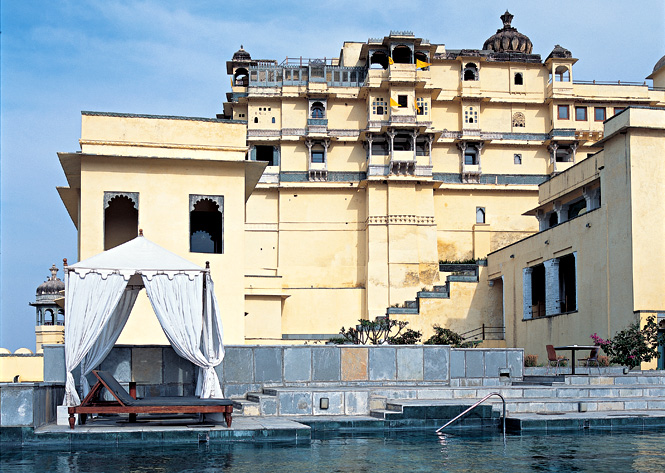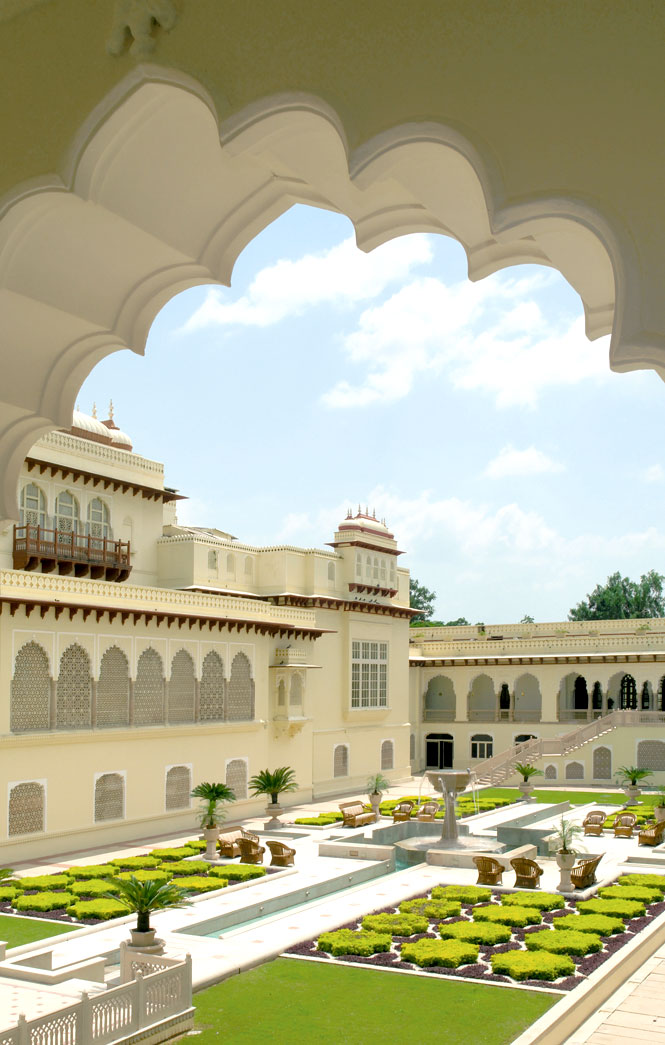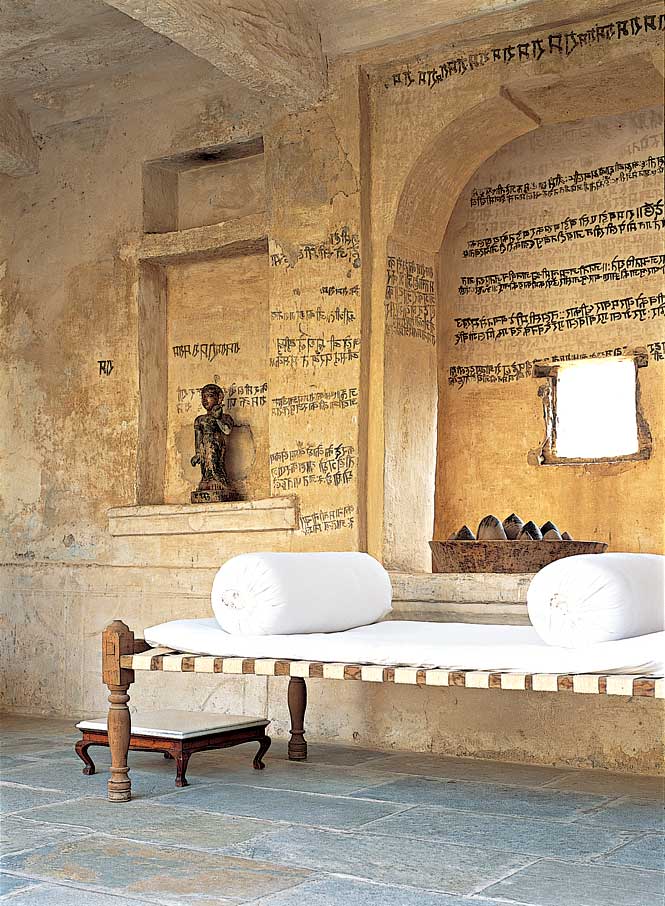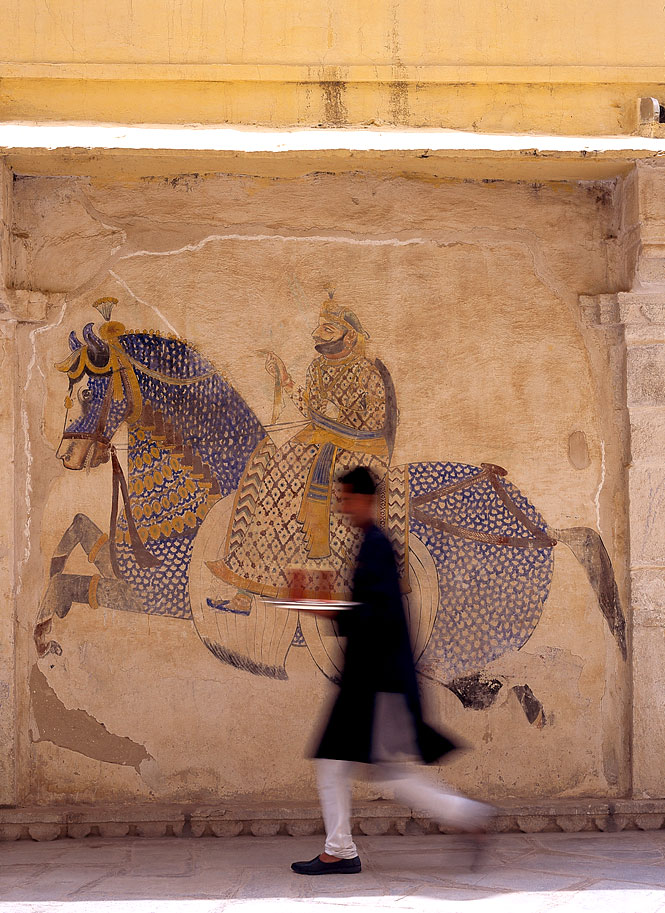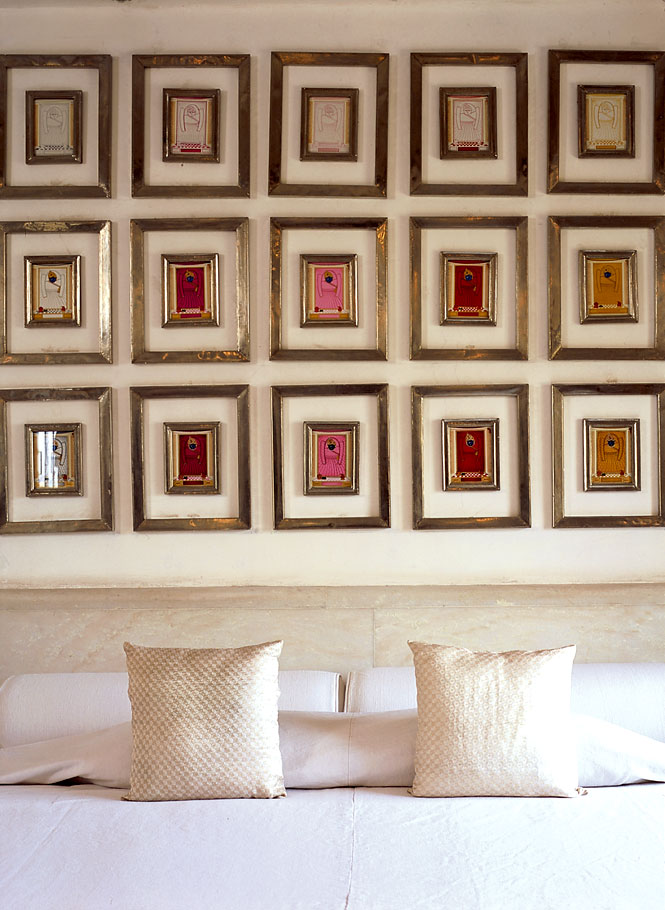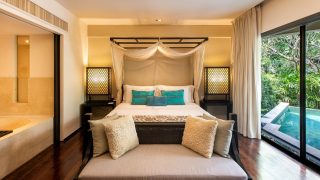Above: Poolside at the Devi Garh, an 18th-century fortress-turned–boutique hotel in the Aravalli Hills outside Udaipur.
The forts and palaces of India’s “land of princes” recall an age of grandeur once savored by maharajas—and with many of these historic properties having been converted into hotels over the years, visitors can also get a taste of Rajasthan’s storied opulence. Here are some of our favorites.
By David Tse
Photographs By Jacob Termansen & Ken Hayden
A land of fairy-tale fortresses and marble palaces perched above arid plains or sparkling lakes, Rajasthan—India’s second-largest state—lures more travelers than any other part of the country. Vibrant festivals and teeming wildlife reserves are part of the draw, but the principal attraction is the architectural legacy of the Rajputs, clans of warrior princes who rose to prominence here in the seventh century. Stripped of their feudal prerogatives in the decades following Indian independence, many Rajput families have since embraced tourism, converting their forts, haveli mansions, and palaces into grand hotels. Today, Rajasthan is home to well over 100 such heritage properties, and we’ve combed through a handful of the best for the benefit of anyone looking to live out their maharaja—or maharani—fantasies in inimitable settings.
Above: Details at the Devi Garh include sun-bleached frescoes and bedrooms that combine contemporary and traditional touches.
Devi Garh
Credit Delhi style mavens Lekha Poddar and her son Anupam for transforming this 18th-century stronghold from a neglected ruin into one of Rajasthan’s most beguiling boutique hotels. Cradled in the rugged Aravalli Hills northeast of Udaipur, the Devi Garh is a fairy-tale fortress of yellow sandstone ramparts, faded frescoes, vast guest chambers, and sun-bathed courtyards. Each of the 39 suites has been designed to make the most of the eccentricities of the original layout; some sport domed balconies or bay windows, while others have tented terraces that open onto Mughal-inspired gardens. It’s a grand and romantic setting in a state famed for such things. But unlike so many other heritage properties, the Devi Garh has eschewed period furnishings in favor of a clean, pared-down aesthetic that puts a contemporary spin on traditional motifs, like glistening white marble walls inlaid with lapis lazuli, mother-of-pearl, and malachite. The result is an irresistible fusion of Rajput opulence and sleek, modern luxury, augmented by understated service, a daily-changing thali menu, and a charming rural locale (Delwara; 91-295/328-9211; deviresorts.com; doubles from US$378).
Rambagh Palace
The onetime residence of the maharaja of Jaipur, Rambagh Palace has seen many incarnations over its 174-year history. Originally designed as a home for the queen’s favorite handmaiden, the property was then converted into a guesthouse and hunting lodge before Maharaja Sawai Man Singh II hired British architect Samuel Swinton Jacob to transform it into the palace that it is today. A boutique hotel since 1957, the Rambagh sprawls across 19 hectares of sculpted gardens, considered among the finest in Jaipur. But it’s the sumptuousness of the 79 rooms and suites that helped earned this retreat its reputation as the “Jewel of Jaipur.” Four-poster beds come swathed in silks, windows are draped with rich, embroidered fabrics, carved pillars lead to marbled bathrooms, and walls shimmer with intricate mirror-and-tile inlays. The main dining room (a former banquet hall) is a sight in its own right, with soaring frescoed ceilings and green-marble pilasters; while the clubby Polo Bar is the perfect place to nurse a refreshing gin and tonic. The Grand Jiva Spa is the only new building on the estate, although it nods to tradition with an expansive menu of time-honored Indian therapies (Bhawani Singh Rd., Jaipur; tajhotels.com; 91-141/221-1919; doubles from US$231).
Umaid Bhawan Palace
Said to be one of the largest private residences in the world—during construction they employed more than 5,000 men for some 15 years—this golden-yellow sandstone fortress sprawls over Chittar Hill, high above Rajasthan’s Blue City. Jodhpur’s titular ruler, Maharaja Gaj Singh II, whose grandfather commissioned the palace in 1929, still resides here with his family. The remainder of the 347 rooms have been converted into a small museum and a lavish 76-suite hotel. Designed by renowned Edwardian architect Henry Lanchester, the building is a confection of architectural styles: the towers showcase grand Rajput designs, the 32-meter-high cupola is a Renaissance delight, and the rooms (each is unique) come with Art Deco flourishes. The Maharaja Suite sports dramatic wildlife frescoes by Polish artist Stefan Norblin—a theme copied in the Trophy Bar, where faux tiger-skin cushions sit beside an impressive collection of antique hunting gear. Step onto the large verandah and you’ll witness the real thing: the palace grounds cover 11 hectares of neatly clipped gardens and courtyards where peacocks roam free (Chittar Hill, Jodhpur; tajhotels.com; 91-291/ 1251-0101; doubles from US$389).
Taj Lake Palace
There are few hotels as romanticized as the Taj Lake Palace, a shimmering white-marble-and-mosaic monument occupying all of Jag Niwas Island in Udaipur’s jade-green Lake Pichola. Built in 1746 as the summer palace of Maharana Jagat Singh II, the turreted retreat now houses 83 rooms set around bougainvillea- laced courtyards and gardens. The royal treatment begins from the moment you arrive aboard the hotel’s polished launch: a staff of butlers—descendants of the original palace retainers—will see you to your quarters, which have been individually designed and named after the kings and queens who once called them home. Among the finest, the Sajjan Niwas suite enjoys an old-world charm afforded by traditional cloth fans, mirrored furniture, and frescoed walls. Step onto your private balcony to enjoy sunsets over the Aravalli’s and Pichola’s other island, Jag Mandir, while being serenaded by flautists performing ragas from their rampart perch. Diversions range from private dinners on the Mewar-style terrace to lazy afternoons spent on the hotel’s Jiva Spa Boat, a floating spa suite offering signature treatments and imperial bathing rituals (Lake Pichola, Udaipur; 91-294/252-8800; tajhotels.com; doubles from US$245).
Samode Palace
Set in the medieval town of Samode outside Jaipur, this 400-year-old palace is an imposing example of Rajput-Mughal architecture. Rising from the foothills of the Aravalli Hills, the stepped sandstone building unfolds through a progression of courtyards and halls. The main Durbar Hall is lined with jaw-dropping 250-year-old frescoes, while the Sultan Mahal sparkles with a blue-and-silver mirrored terrace—design features replicated across the hotel’s 43 suites. Large and light-filled, they’re furnished with a mix of antiques and modern pieces, swathed in soft silks and colorful block-printed Rajasthani textiles. The three Royal Suites enjoy the best views of the surrounding mountains, and come with a leafy private courtyard, Jacuzzi, and open fireplace. The majestic setting earned the palace a starring role in the 1984 miniseries The Far Pavilions—both a blessing and a curse. That meant the addition of a new, and rather charmless, hotel wing as well as a lovely rooftop infinity pool (Samode, Jaipur; 91-1423/240-014; samode.com; doubles from US$194).
Neemrana Fort-Palace
This 15th-century fort is one of India’s oldest heritage hotels, transformed from a near-derelict state by the Neemrana Hotel Group, which operates some 15 other heritage properties across the subcontinent. The princely estate sprawls over 10 hectares atop a plateau in the desert between Delhi and Jaipur. Set over nine levels in five wings, the 50 rooms and suites vary in size and price—if you’re on a budget, some rooms can be snapped up for a song—and come with intricate jali screens, cusped arches, four-poster beds, and windowside nooks strewn with colorful pillows. While amenities are modern, and include a superb swimming pool with commanding views of the valley below, Indian artists were called upon to give the decor local flavor. Come dusk, the palace becomes the stuff of fairy tales, spotlit in different colors to give it an eerie glow. Although there’s not much to keep you entertained in the area (with the exception of new zip-lining excursions), the fort itself is well worth exploring, with a maze of hidden niches and courtyards in which to lose yourself (Neemrana, Alwar; 91-11/ 4182-5001; neemranahotels.com; doubles from US$142).
Originally appeared in the August/September 2009 print issue of DestinAsian magazine (“Regal Rajasthan”)

